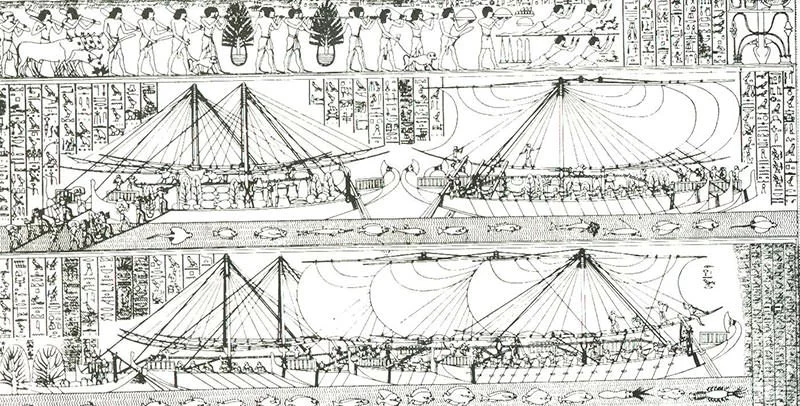Hatshepsut was the longest reigning female pharaoh of an indigenous dynasty of ancient Egypt. Daughter of Thutmose I and wife of Thutmose II, Hatshepsut took the role of a regent after the early demise of her husband. For reasons not entirely clear, she then assumed complete power becoming the de facto ruler of ancient Egypt. She was the fifth pharaoh of the Eighteenth Dynasty of Egypt, ruling for 20 years from around 1479 BCE to 1458 BCE. Hatshepsut is regarded as one of the most successful pharaohs as she oversaw a period of peace and prosperity; re-established trade relations; and oversaw the completion of some of the finest construction projects in the history of ancient Egypt. Due to her achievements, she has been called “the first great woman in history of whom we are informed.” Know more about the great female pharaoh of ancient Egypt through her 5 major accomplishments.
#1 She is one of the few female pharaohs of ancient Egypt
Hatshepsut was the daughter of Pharaoh Thutmose I and his wife Ahmose. She was married to Thutmose II, her half brother from a secondary wife of Thutmose I. After the death of their father, the throne was passed on to Thutmose II. After the death of Thutmose II at a young age, the widowed Hatshepsut was made regent to rule for her stepson, Thutmose III. But, by the end of his seventh regnal year, she became the official co-ruler and de facto ruler of ancient Egypt. The reason behind this is debated with early historians suggesting that she usurped the throne while recent ones arguing that a political crisis obliged her to become pharaoh. Whatever might be the reason, Hatshepsut was one of the very few female pharaohs. According to Egyptologist Ian Shaw: “In the history of Egypt during the dynastic period (3000 to 332 B.C.) there were only two or three women who managed to rule as pharaohs”.
Main Sources:-
B. Wilson, Elizabeth. (2006). “The Queen Who Would Be King”. Smithsonian Magazine.
Jarus, Owen. (2018). “Hatshepsut: Powerful Female Pharaoh”. Live Science.

#2 Hatshepsut was the longest reigning indigenous female pharaoh
Hatshepsut was the fifth pharaoh of the Eighteenth Dynasty of Egypt. She was the second historically confirmed female pharaoh, the first being Sobekneferu. Hatshepsut was the longest reigning female pharaoh of an indigenous dynasty of ancient Egypt, ruling for 20 years in the 15th century BCE from around 1479 BCE to January 16, 1458 BCE. Her long reign was a time of peace and prosperity in ancient Egypt due to which she is regarded as one of Egypt’s most successful pharaohs. According to Egyptologist James Henry Breasted, Hatshepsut is “the first great woman in history of whom we are informed.”
Main Sources:-
“Hatshepsut”. State Information Service.
Wilkinson, Toby (2010). “The Rise and Fall of Ancient Egypt”. pp. 181
#3 She oversaw the most famous Egyptian expedition to the Land of Punt
The Land of Punt was an ancient kingdom and a trading center on the East African coast beyond the southernmost end of the Red Sea. Punt was known for producing and exporting gold, aromatic resins, blackwood, ebony, ivory and wild animals; among other things. Hatshepsut sanctioned and oversaw the preparation of the most famous Egyptian expedition to the Land of Punt. In exchange of Egypt’s linen, grain and papyrus; ebony, obsidian (volcanic glass), myrrh trees, wild animals and incense were brought back to Egypt from Punt. The Punt expedition was a foreign relation triumph for Hatshepsut and it is believed that no Egyptian pharaoh had ever been so successful in Punt. Moreover, based on this successful expedition, historians consider Punt the traditional trade partner of ancient Egypt.
Main Source:-
Anoba, Ibrahim. (2019). “Commerce And Trade In Ancient Africa: Egypt”. libertarianism.org.

#4 Hatshepsut was one of the great builder pharaohs
As pharaoh, Hatshepsut undertook enormous and ambitious building projects> which may still be seen in Egypt. She was one of the most prolific builders, commissioning hundreds of construction projects across her empire. She began with the erection of two 100-foot-tall obelisks at the Great Temple Complex at Karnak. At the time, they were the tallest obelisks in the world. In the area around Thebes, the dynastic and theological center of her dynasty, she built a network of imposing processional roadways and sanctuaries. Toward the end of her reign, Hatshepsut erected a second pair of obelisks at Karnak. The construction projects of Hatshepsut were arguably more numerous and grander than her Middle Kingdom predecessors.
Main Sources:-
B. Wilson, Elizabeth. (2006). “The Queen Who Would Be King”. Smithsonian Magazine.

#5 Her Mortuary Temple is regarded as an architectural wonder
Deir el-Bahari is a complex of mortuary temples of ancient Egypt. It is located on the west bank of the Nile, opposite the city of Luxor, Egypt. The Mortuary Temple of Hatshepsut, also known as the Djeser-Djeseru, is located beneath the cliffs at Deir el-Bahari next to the Temple of Mentuhotep II. It is widely regarded as one of the greatest achievements of Hatshepsut and one of the architectural wonders of the ancient world. Hatshepsut’s temple was decorated with scenes marking the achievements of her reign and housed shrines to Anubis, god of the dead, Hathor, goddess of fertility; Amun, king of gods; and Re, god of the sun. Senenmut, the official overseer of works at Deir el-Bahri, was the architect of the temple.
Main Sources:-
Khan, Gulnaz. (2018). “This Temple Honors the Egyptian Queen Who Ruled as King”. National Geographic.
B. Wilson, Elizabeth. (2006). “The Queen Who Would Be King”. Smithsonian Magazine.

